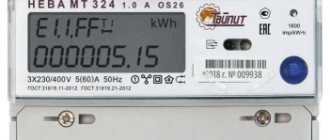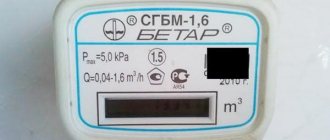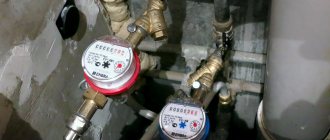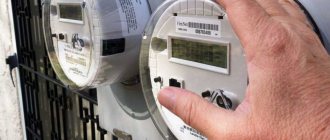Each apartment, private house or industrial facility must have energy metering. The device from which readings are taken are electricity meters. In order to avoid overpayments, you should monitor the technical condition of the electricity meters during operation and replace them in a timely manner when their service life expires. The organization of verification and replacement of the electric meter according to legislative acts is entrusted to the owner of the house or apartment. There are a number of reasons that justify replacing the electricity meter.
Factors that determine when to replace a meter
First of all, you need to change the electric meter if it malfunctions. If the electricity meter breaks down, the signs that determine its condition will be the following:
- traces of melting will appear on the body of the device;
- traces of burning may appear on the glass of the window, on the wires, on the same body;
- when there is no load, the device continues to change readings;
- when checking the meter connection diagram, if there is voltage at the input, there is no voltage at the output;
- The meter indicator is “silent” when a load is applied to the electric meter.
There are a number of other reasons that make it necessary to replace the electricity meter.
- All old-style meters with an accuracy class of 2.5 or more must be replaced. This is due to the large measurement error of such devices, which was the impetus for the issuance of a decree of the Russian Federation on the mandatory use of more accurate means of determining electricity consumption.
- The meter makes a lot of noise during operation. There may be several reasons: from the use of an outdated model to moisture and dust accumulated inside the device.
- The meter produces information that is difficult to understand. This problem usually happens with electronic meters where individual elements do not work.
- There are doubts about the correct display of electricity consumption by the device. When the load increases, the readings may increase quite slowly, and when the load decreases, nothing may happen, the readings do not change.
- The basis for the replacement is the transition to a multi-tariff system. It is practiced where there are differences in the cost of electricity during the day and at night.
- Technological progress does not stand still; so-called “smart” meters are appearing. They transmit readings directly to the electrical energy producer.
Installation features
The rules for replacing an electric meter in a private home are relatively simple. But the main aspect of successfully completed work is the acquisition of high-quality equipment.
Criterias of choice
Today there are several types of metering devices: induction and electronic. The first contains 2 coils, the magnetic field of which drives a disk that rotates the mechanism for calculating the consumed electricity.
The main advantages of an induction device:
- simple design;
- reliability of the device;
- long service life (about 20 years).
Electronic equipment calculates the electricity consumed thanks to special microcircuits. In this case, the electric meter is equipped with a voltage sensor that transmits information about the electricity used. These devices are more expensive and have a shorter service life, unlike induction ones, but they also have important advantages:
- it is possible to determine the power consumption for a specific period of time, and, in general, provide more accurate data;
- can perform multi-tariff metering, while the device itself switches to the appropriate tariff;
- information about voltage parameters, voltage drops, and power outages is saved;
- The equipment transmits readings to the electricity supply company at the required time and does this independently.
Modern devices are preferable on the part of the energy supply company, because... they are much better protected from electricity theft.
Today there are so-called “smart electricity meters”, but they are the most expensive among other devices Source future2day.ru
In addition, electricity meters are single-phase and three-phase. The latter are installed in houses whose owners have powerful electrical equipment that requires three-phase current.
Other options when selecting:
- in some tariffs, electricity at night costs much lower than during the day, that is, it is advisable to purchase two-tariff electricity meters, thus reducing electricity costs;
- if the device is required for light loads, then it is recommended to connect it directly; if these are high loads, then the device is connected via a transformer;
- accuracy class, which allows you to find out the error of the measurements made.
The accuracy class of an electric meter must be indicated on the device body Source strojdvor.ru
Replacement procedure
Replacing an electric meter in an apartment, private house, industrial or other facilities is impossible without obtaining permission from the energy company that supplies electricity to a specific consumer. The fact that the meter is owned by the consumer does not allow him to independently open the seals in order to avoid penalties, since they belong to the supplier company.
Where to go to get permission
- You can contact the energy company in person. There is no standard form; it is written in free form, for example, as in the image.
After registering the application, the energy company will send a specialist who will record the meter readings. The presence of almost every mobile phone with a photography function simplifies this process. An image of the meter with readings taken using mobile electronics can be printed and sent to the energy company along with the application. A specialist will be needed only at the sealing stage after the meter replacement procedure, where he will check the readings from the photograph. - An inspector can be called to your home. As a specialist, he will check the feasibility of replacement, which he will confirm with the appropriate document and open the seals.
- If there is no voltage in a house or apartment due to a faulty meter, you must use the services of an emergency service. The arriving specialist has the right to remove the seals or will limit himself to permission for this action. After which the emergency service will notify the energy company so that the replacement of the device is official.
Who should change
Any person with knowledge of electrical engineering and practical experience in this field of activity can change the electricity meter. An electrician from an electricity supply organization can do the replacement, you can invite a specialist from a housing and communal services office, or simply ask an electrician you know to do the work. Is it possible to change the electricity meter in an apartment yourself? No one forbids doing this, but you should know that responsibility for the quality of work lies with the contractor.
In an apartment building, the landlord is not always obliged to replace the electricity meter, even if he lives in a privatized apartment. If the electrical device is located in the entrance, on the staircase, then it belongs to the common property of the house and the management company must monitor its technical condition. In exceptional cases, when the device breaks down due to the fault of the owner or the agreement with the management company stipulates that the owner must replace the electric meter in the apartment, problems with replacement are not within the scope of the management company.
In almost all cases, an electric meter in a private house must be purchased, installed and, if necessary, replaced with a new one by the owner of the house. Installation of metering devices in such houses, at the request of the electricity supply organization, is carried out on the street, which makes it easier for inspectors to take readings. However, this goes against the PUE (Electrical Installation Rules), according to which the meter must be installed in dry rooms with a temperature not lower than 0 °C. This requirement can be used when concluding an agreement on balance sheet ownership with a resource supply company. When installing a meter on a street pole, it should be reflected in the document that responsibility for moving or replacing the meter should be borne by representatives of the electricity supplier company.
Video description
The correct installation of a single-phase meter is shown in this video:
Three-phase
Electricity meters of this type are replaced only in cases where significant amounts of electricity consumption are required. At the output, the devices can produce both 220 Volts and 380 Volts; these are optimal indicators for many types of production equipment. In addition, three-phase devices prevent any voltage fluctuations.
Connecting a three-phase meter is much more complicated, unlike a single-phase one, this will require a higher level of training from an electrician Source elektro.guru
Step-by-step instructions on how to change an electricity meter:
- the power cable has 3 phases, neutral and ground;
- the phase is connected to the 1st, 3rd and 5th contact;
- the equipment is tested and possible faults are identified;
- electricity is supplied from the remaining free contacts;
- The grounding is fixed to a special bus, while zero is supplied to the “ground”.
How to change an electric meter with your own hands
If, after receiving permission to replace the meter, you decide to do the work yourself, then, regardless of the presence or absence of experience as an electrician, you should follow the following sequence of actions.
When removing the meter, the following conditions must be met:
- the circuit breaker in front of the meter should be turned off;
- remove the seals (if permission is available) from the lid and open it;
- use an indicator screwdriver to check the absence of voltage on the meter;
- Before disconnecting the wires, you should sketch out the wiring diagram; you can, for example, wrap the ends of the wires with white electrical tape, on which you can make the necessary marks;
- then the wires are disconnected and the device is removed;
- be sure to insulate the disconnected wires for any unforeseen cases;
- The removed meter is not thrown away; it is handed over to the energy supply organization along with the readings at the time of removal.
The process of installing a new meter consists of the following steps:
- Before installation, you need to check whether the circuit breaker is turned off;
- additionally check with an indicator screwdriver that there is no voltage on the phase wires;
- you should open the cover of the device being installed to provide access to its terminals;
- remove the emergency insulation from the wires;
- connect the meter according to the diagram sketched when removing the old meter;
- wires that are fixed in terminals with screws must be securely clamped;
- The operation of the meter is tested in various modes of electricity consumption in the apartment.
After installing the meter, it is necessary to put it into operation, for which the following actions are performed:
- an application is written to the energy supply company to seal the meter;
- payment is made through the bank for sealing services;
- the time of arrival of the inspector is agreed upon;
- inspector checking that the device is connected correctly;
- if there are no comments regarding the installation, a seal is placed on the meter and on the input machine (located directly in front of the meter);
- In the end, everything is completed by issuing a report on the work performed, which includes the following information: readings of the old meter, readings of the new meter, brand and serial number of the meter, as well as installation time.
After all the above steps, the meter is put into operation, and payment for electricity will be made according to its readings.
What are the features of paying for electricity when changing a meter?
Despite the absence of an electric meter, life in the apartment continues, household appliances fulfill their functional purpose. Electricity consumption between the removal of the seal and the acceptance of the meter into operation is determined according to a tariff specially established for this case. In the first three months, a kilowatt of electricity is paid at a price based on the average taken over the last six months before replacement.
If the apartment owner does not change the metering device within three months, then payment is made at a tariff with increasing coefficients. From a savings point of view, it is better to take measures to replace it as soon as possible.
Household meter - payment details
The lighting of the yard, entrance, and elevator operation are paid for by the residents of the apartment building. A common house meter determines losses on highways and helps to pay according to the fact, and not according to standards. Residents of the building will have to pay for the installation of a communal meter through the management company.
If apartment owners refuse to pay for its installation, it will be carried out at the expense of financial resources from the local budget. But be prepared for the fact that in the future the amount spent will be added to the utility bills and the apartment owners will still have to pay.
Recommendations for purchasing a new meter
Regardless of the type of meter purchased (induction, electronic, multi-tariff, single-phase, three-phase), in addition to wondering how much the device costs, you need to pay attention to its following characteristics.
- Check the date of the initial meter inspection. PUE (Rules for the Construction of Power Installations) regulate the possibility of installing a metering device if two years have not passed since the initial inspection for single-phase meters and one year for three-phase ones.
- The brand of the meter should be agreed upon with the energy supply organization. It may not be suitable for the accuracy class and in this case will not be accepted for use.
- Check the presence and integrity of seals on the metering device. To access them if you don't know where they are, ask the seller for their location.
- Carefully inspect the meter housing. There should not be any damage to it. The presence of even a small crack will be grounds for refusal to accept the device for operation.
- Be sure to fill out the warranty documents and keep the receipt in case of a factory malfunction of the meter to return it to the store.
In what cases is it necessary to replace the meter?
An electricity meter is a device that has its own technical characteristics and service life. Before starting work, accounting devices are sealed twice. One seal is placed on the mechanism body at the manufacturer’s factory.
It is called a state verification seal and indicates that the meter is not mechanically damaged and is ready for use. Another seal is installed on the safety cover by the energy supply company.
Both seals are numbered, just like the electrical appliance itself, and if they are damaged, the culprit faces a fine. All numbers are recorded in the meter installation certificate, which is a strict reporting form. Reinstalling the meter entails making changes to the documentation, so grounds for its replacement are required. These include:
- The device failed due to mechanical impact.
- The meter has stopped showing current readings.
- The model of the mechanism is outdated and the energy supply company offers to replace it with another modification.
All cases of meter replacement are stipulated in the electricity supply agreement, which is concluded between the resident and the power engineers. The agreement usually stipulates at whose expense the electrical appliance will be replaced.
Features of installing smart meters
The transition to “smart” metering devices is regulated by Federal Law No. 422 of May 4, 2012. One of the points establishes who will pay for this transition from 2021. Since the resource supplying organizations will benefit, they will bear the installation costs. “Smart” meters will reduce the cost of checking and taking readings, since they will provide accounting and verification independently, without the use of additional human resources. They can be equipped with the function of cutting off the electricity supply to debtors.
Replacement will be carried out gradually due to reaching the end of the service life of the electric meter, or its emergency condition. Construction projects commissioned from July 1, 2020 must already be equipped with “smart” metering devices.
Solving the problem of how to replace an electric meter is not particularly difficult. To save money, you can do the replacement work yourself. When performing work, you just need to show care and responsibility. However, the presence of an electricity supplier is mandatory, at least to establish the legality of the new meter.
The legislative framework
Legislation on the installation of electric meters in individual houses
Before starting work, it is imperative to study the current regulations.
There are not many requirements, but deviations from the rules are fraught with sanctions from the supervisory authority. The procedure for installing electrical wiring and installing/replacing meters is regulated:
- Civil Code (Articles 541-544);
- “Rules for electricity metering” (Resolution of the Government of the Russian Federation dated November 2, 1995 No. 1087).
Only qualified specialists are entitled to service power consumption measuring instruments. Dismantling and replacement of equipment is carried out only with the permission of the service organization - clauses 4.3 - 4.7 of the Rules.











